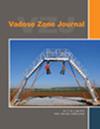利用 HYDRUS 模拟页岩丘陵山坡土壤优先流的维度和尺度
IF 2.8
3区 地球科学
Q3 ENVIRONMENTAL SCIENCES
引用次数: 0
摘要
优选流(PF)过程受不同尺度的地下土壤结构支配。然而,目前仍缺乏对 PF 的模型验证和机理认识。我们假设,如果忽略小尺度空间可变过程并简化模型维度,就无法描述和量化山坡及更大尺度的优先流过程。我们的目标是通过比较多维(一维、二维和三维)和多尺度(块根、鲶鱼和集水区)建模方法与综合数据集的模拟结果,对基于理查兹方程(由 HYDRUS 软件求解)的 PF 模拟进行评估。结果表明,一维模拟与土壤水分数据之间的一致性有限,主要受孔隙度、渗透性和降水特征垂直变化的影响。二维和三维模拟结果优于一维模型。考虑到土壤和基岩结构在三个维度(垂直、水平和周围区域)上的精确表现,三维模拟对花生阶地尺度上的 PF 动态描述令人满意。在花盆尺度的二维模拟中,包含土壤双孔隙度和各向异性的模型比单孔隙度和各向同性模型能更准确地预测水动力学。此外,由于加强了对沿坡不同位置之间水力连通性的表述,在基带尺度上应用二维模拟确定了PF路径。研究结果证实了多维和多尺度建模方法在山坡水文的 PF 模拟中的重要性。考虑到二维和三维 "自下而上 "物理模型在表示土壤剖面和/或基岩地质内部和之间的空间变异性方面的复杂性和参数化,研究结果有助于创建一个建模框架,用于识别坡面降水过程及其对水资源管理的影响。本文章由计算机程序翻译,如有差异,请以英文原文为准。
Dimensionality and scales of preferential flow in soils of Shale Hills hillslope simulated using HYDRUS
Preferential flow (PF) processes are governed by subsurface soil structures at various scales. Still, model validation and mechanistic understanding of PF are very lacking. We hypothesize that PF at hillslope and larger scales cannot be described and quantified when neglecting small‐scaled spatially variable processes and simplifying the model dimensionality. The objective was to learn from comparing simulation results of multidimensional (1D, 2D, and 3D) and multiscale (pedon, catena, and catchment) modeling approaches with comprehensive datasets, and so as to evaluate PF simulations based on the Richards’ equation (solved by the HYDRUS software). Results showed limited alignment between 1D simulations and soil moisture data, mainly affected by vertical changes in porosity, permeability, and precipitation features. 2D and 3D simulations outperformed 1D models. 3D simulations provided satisfactory description of PF dynamics at the pedon scale, considering accurate representations of soil and bedrock structures for three dimensions (vertical, horizontal, and surrounding area). In 2D simulations at the pedon scale, models incorporating dual‐porosity and anisotropy of soils yielded more accurate predictions of water dynamics than single‐porosity and isotropic models. Furthermore, the application of 2D simulation at the catena scale identify PF pathways owing to the enhanced representation of the hydraulic connectivity between different locations along the slope. The results confirmed the significance of multidimensional and multiscale modeling approaches for PF simulations in hillslope hydrology. Considering the complexity and parameterization of 2D and 3D “bottom‐up” physically based models in representing spatial variability within and between soil profiles and/or underlying bedrock geology, the results contribute to creating a modeling framework applicable to identify the PF processes and thus their implications in managing water resources.
求助全文
通过发布文献求助,成功后即可免费获取论文全文。
去求助
来源期刊

Vadose Zone Journal
环境科学-环境科学
CiteScore
5.60
自引率
7.10%
发文量
61
审稿时长
3.8 months
期刊介绍:
Vadose Zone Journal is a unique publication outlet for interdisciplinary research and assessment of the vadose zone, the portion of the Critical Zone that comprises the Earth’s critical living surface down to groundwater. It is a peer-reviewed, international journal publishing reviews, original research, and special sections across a wide range of disciplines. Vadose Zone Journal reports fundamental and applied research from disciplinary and multidisciplinary investigations, including assessment and policy analyses, of the mostly unsaturated zone between the soil surface and the groundwater table. The goal is to disseminate information to facilitate science-based decision-making and sustainable management of the vadose zone. Examples of topic areas suitable for VZJ are variably saturated fluid flow, heat and solute transport in granular and fractured media, flow processes in the capillary fringe at or near the water table, water table management, regional and global climate change impacts on the vadose zone, carbon sequestration, design and performance of waste disposal facilities, long-term stewardship of contaminated sites in the vadose zone, biogeochemical transformation processes, microbial processes in shallow and deep formations, bioremediation, and the fate and transport of radionuclides, inorganic and organic chemicals, colloids, viruses, and microorganisms. Articles in VZJ also address yet-to-be-resolved issues, such as how to quantify heterogeneity of subsurface processes and properties, and how to couple physical, chemical, and biological processes across a range of spatial scales from the molecular to the global.
 求助内容:
求助内容: 应助结果提醒方式:
应助结果提醒方式:


